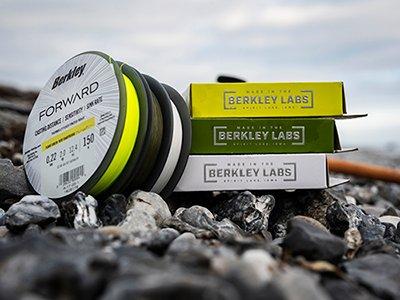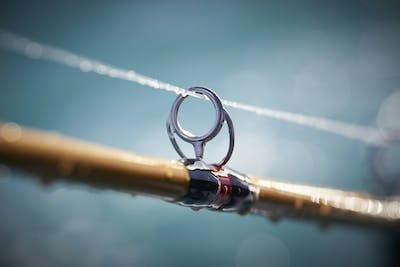The Science of Line & Why Respooling Matters
Respooling often keeps your only connection to that trophy fish fresh.
Generally speaking, a spool of fishing line is relatively mundane and non-descript. Admittedly, beyond a bit of colorful packaging, there’s little to get excited about. Once spooled, line is quickly forgotten and goes mostly unnoticed. That is… until we break it off on a fish.
Fishing is a rough-and-tumble sport. Our gear is subjected to untold bumps and bruises, and fishing line isn’t immune to the fray. We flip, skip, pitch, and punch baits into the most inhospitable of nooks and crannies, drag it across sand bars, bounce it off concrete bridge pilings, and expose it to electromagnetic radiation in the form of ultraviolet light.
As if that weren’t disrespectful enough, we backlash it insufferably on baitcasters and wind knot the snot out of it on spinning gear. Let’s face it; anglers are hard on their fishing line.
ENTER ENGINEERING. – CREATING BETTER, STRONGER LINES.

Today’s modern lines—monofilaments, fluorocarbons, and braids—have all come a long way from their meager beginnings. Early fishermen used what was available, as lines were crudely fashioned from catgut, spun silks, and twisted cotton strands.
In contrast, today’s lines are marvels of mechanical engineering and materials science, incorporating decades of manufacturing advancements and angler suggestions. Fishing line engineers have nearly impossible design parameters: first, they must make line incredibly strong and nearly indestructible. Next, they must make it unfathomably small. To top it off, line must be supple and cast effortlessly.
Fishing lines must be built to withstand tremendous force; they are shot through the rod guides at speeds approaching 150 miles per hour. On the cast, lines deal with acceleration forces of nearly 14 times the force of gravity—nine more than what a human can tolerate before passing out. They are also spun up at 20,000 to 30,000 rpm, resulting in tremendous heat and friction.
Today, mechanical engineers, materials scientists, and chemical engineers formulate, design, and develop new lines in their laboratories. Under their guidance, advancements in polymer science and mechanical engineering are melded together to build the strongest, most durable fishing lines available.
So, just how strong are modern lines?
RATED WHAT? – UNDERSTANDING THE RATINGS ON LINE PACKAGING.
We’ve all seen fishing line with the poundage rating displayed on the box and spool. This number, related in pounds, is the breaking strength of that line. For instance, if a spool of line is rated as “12-pound,” it means that line will break when 12 pounds of force is applied.
Spool labels typically carry other pertinent information, too. This often includes a metric measure equivalent for the poundage rating. For 12 pound test you’d expect to see “5.4 kilograms.” Often you will also see a diameter measurement, defined in a decimal, like 0.009”. This measure is important for those who need a considerable amount of line on their reel. Braids are commonly labeled with an equivalent diameter rating. For instance, 40-pound braid may say it is equivalent in diameter to 12-pound test. This comparison is to monofilament, which is the standard for line diameters.
OH SNAP! WHAT BRINGS LINE TO ITS BREAKING POINT?
Anglers ask a lot of their fishing lines. And as we have seen, fishermen are very hard on their line. But does fishing line have a shelf life? Does it “go bad” if it sits too long? Well, the answer is yes… and no. Of the three types of fishing line, monofilament degrades the fastest.

Monofilament is affected by exposure to ultraviolet light (UV). Under normal circumstances, monofilament loses about 20% of its tensile strength for every 100 hours of exposure to sunlight. Most anglers do not leave monofilament on their reels long enough to expose it to 100 hours of sunlight while fishing. However, if you store your reels in direct sunlight, you can see how quickly monofilament would degrade.
Fluorocarbon lines, on the other hand, are affected considerably less when exposed to sunlight. In fact, they hardly degrade. However, fluorocarbons are not immune to the wear and tear of fishing. Fluorocarbon line, no matter how tough, will suffer nicks and scratches during normal use.
Additionally, knots weaken lines as they contort small diameter lines into pretzels, folding over themselves while under great tension. Even the best tied knot diminishes line strength at the knot location by some 5 to 15%.

Braided lines, on the other hand, are mostly immune to UV light. But they’re not impervious to other modes of degradation. The most common cause of braided line failure is abrasion. Braided lines are a composite of many micro-fibers woven together to form one strong strand of line—much like rope construction. So, nicking or compromising one or more of the small woven fibers can degradate the overall strength of braided line.
Monofilaments and fluorocarbons can also become abraded (nicked, scuffed, burred, etc.) when they brush up against sharp objects. A fish’s teeth may do this, or a dock piling, barnacles, rocks, logs, a boat’s gunnel, or anything else that is sharp.
Many times, fishermen are oblivious to the damage their line has suffered. As they continue to fish, the damage may worsen, and their line could fail when they set the hook or are fighting a fish, thereby putting additional stress on the line’s imperfection.
Something as ordinary as a backlash on a baitcasting reel can crease a clear line (i.e., monofilament or fluorocarbon) and weaken it. Wind knots on spinning reels can cause the same damage.
Improper knot tying, whether to the lure, hook, swivel, and/or leader can damage line, too. A knot that has not been cinched down properly can slip and will often break. A knot which has not been wet when tied is susceptible to breakage since it was damaged by heat and friction before it ever hit the water.

Sharp sinkers and lures themselves can damage our lines. Sharp sinker collars can abrade lines as they slide up and down their length. Crimp-on sinkers (i.e., split shots) are particularly tough on lines as they fold the line and deform it, flattening it and causing a weak point.
Interestingly, however, fighting and landing a fish, with your drag set correctly, rarely damages fishing line. But if your drag is incorrectly set, or the rod action is too stiff for the line you are using, undue stress is placed on the line, and exceeding its rating will result in breakage. It’s critical to match line weight to the rod action and to the lure weight you are throwing to maximize your line’s performance.
As you can see, we demand a lot from our lines. They’re the only connection we have to our baits and—ultimately—the fish we covet so much. That’s why we need to take care of our line, and to change it when it can no longer do the job. But how often do we actually need to respool?
BOTTOM LINE – RESPOOLING FREQUENCY MATTERS.
The answer isn’t cut and dry. A good rule of thumb is to check your line before every fishing trip. A quick running of your fingers down the line’s length will immediately identify inconsistencies or imperfections. The first 6 or 7 feet of line receive the most wear. If you feel nicks or abrasions, cut the line above the problem area and retie your lure.
For competitive fishermen, it’s recommended you respool before each tournament. This practice will remove any doubt you may have about your line when prize money is “on the line.” For weekenders, respool your line at the beginning of every season, and maybe once or twice during the season to keep it fresh.
Additionally, respool prior to any vacation or long-distance trip. No one wants to experience line failure on the trip of a lifetime, and searching for your favorite Berkley fishing line while on the road can eat up valuable fishing time. The bottom line is, line works hard for us, and by giving it a little attention now and then, we can ensure it’s working to its best capacity with every cast.